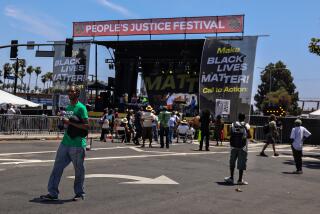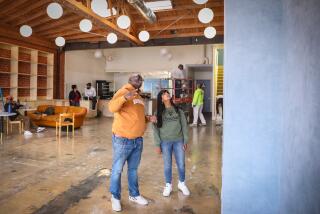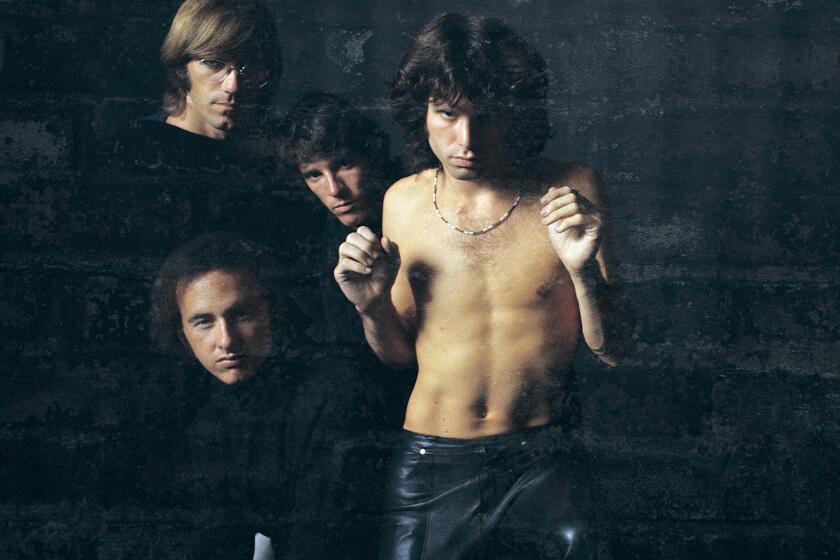Today’s young protesters see injustice through a different filter
Najee Ali is an old hand at activism. Jesse Jackson was his mentor; he’s Al Sharpton’s protege. So Ali thought he had everything in place for a peaceful protest of the verdict in the Trayvon Martin case this week.
But somewhere between the opening prayer and Walmart being trashed, something went terribly wrong with Monday night’s Crenshaw-area rally.
While a few hundred folks were gathered at Leimert Park, praying, singing and venting, dozens of unruly young people began commandeering the streets. Many were captured on camera breaking store windows, assaulting strangers and vandalizing cars along Crenshaw Boulevard.
At least 14 people — most of them teenagers — were arrested that night by the Los Angeles Police Department.
That violence, of course, is what captured our attention, eclipsing the peaceful vigil and giving the South Los Angeles protest a very public black eye.
There was “anger, embarrassment and hurt” among the crowd in Leimert Park, Ali recounted. “It hurt that our young people had let us down, because they don’t realize that a few teenagers’ actions can damage all the work we’ve done trying to uplift Trayvon Martin.”
But it’s not as simple as thugs gone wild.
Certainly there were more than a few hoodlums in that crowd. But there were also aimless young people, not violent, just antsy and confused.
“Of the hundred people I saw heading down Crenshaw, maybe 20 of them had the intent to make trouble,” said Marqueece Harris-Dawson, who heads the Community Coalition, which brought about 50 teenagers to the rally. He had to talk some of them into sticking around.
“It’s crazy, because all of a sudden from every direction, kids are running to a certain spot, and you can’t tell where that spot is or why they’re doing it, because you’re not on that Twitter page,” he said. “They’re just running up and down Crenshaw.
“You stop and ask them what they’re doing, and they didn’t know. It was ‘We just did not want to stand in this park, listening to people talk. We’re way past speeches. That doesn’t cut it for me.’
“This is not your grandmother’s civil rights movement … walking slowly, carrying signs,” Harris-Dawson said. “They don’t do things the way we do. And we don’t know how to organize or control it.”
::
The Florida jury’s acquittal of George Zimmerman is sparking protests across the nation. Most are orderly and lawful, but in California, police had to quell violence along Crenshaw, in Oakland and at two protests in San Bernardino County this week.
Some of that violence has been sparked by fringe groups, “outside agitators” in the parlance of community residents and police.
In Oakland, masked protesters roamed the streets, breaking windows and bashing cars. Locals tried to intervene. Police suspect it was the same band of “anarchists” who disrupted peaceful protests two years ago after the trial of the BART cop who shot Oscar Grant. Of the nine people arrested Monday night, six were from outside of Oakland.
At the Leimert Park protest, a small band of radicals from the Revolutionary Communist Party “showed up with the explicit intent of having a confrontation with the police,” Harris-Dawson said. “A white kid would run up and get in a cop’s face and start yelling, and a member of our community would pick them up and carry them away.”
Crenshaw High junior Timothy Walker witnessed the same thing. The communists “were on, like, a whole different agenda.” They didn’t start the violence, he said, “but they fed into what people were feeling, got them riled up a little bit more.”
Timothy, 16, has been working with the coalition to help organize his peers to work for change constructively. There’s a lot of untapped potential in neighborhoods like his, but adults don’t seem to be listening.
“It’s not that we don’t care about the issues,” he said. “When I first heard the verdict and checked my social networks, not one post I saw wasn’t about Trayvon Martin. We just don’t have a place to show how we feel.
“We see the adults talking for us, and we don’t really get a chance to be at the forefront. Then when we do get a chance, it comes out kind of violent, like we saw on Monday night.”
::
The civil rights establishment is going to have to change its tactics and its focus to get this younger generation on board.
“Everybody who was born after the riots, we’ve never really been through this,” Timothy pointed out. “Before Trayvon Martin, we didn’t have that kind of feeling of injustice.
“And it’s hard to think about what to do if we’re mad or frustrated. So you just disengage, because you think there’s nothing we can do to change things.”
The aim of the Leimert Park protest was to push for federal prosecution of Zimmerman and changes in “stand your ground” laws.
But Harris-Dawson, who’s worked with hundreds of youths in the coalition’s education and community programs, said that’s not the young people’s agenda. Their civil rights battle is different from ours.
“We’ve been successful in beating back blatant racism,” said Harris-Dawson, who is 42. “What they’re dealing with is much more complicated and harder to get your arms around.”
They don’t see the Trayvon Martin case as a product of centuries of racial injustice or a cry for policy changes.
“They see it more as a popular culture issue … about fashion and guns and being profiled because you’re young.”
This case felt personal to them because it mirrors what they feel on the streets — judged because of the way they dress, worried that the guy next to them has a gun.
“They related it to the hoodie, where generations before them would have emphasized the racial aspects,” Harris-Dawson said.
They’re more concerned with getting guns off the streets than putting Zimmerman on trial again. And they don’t need to gather in Leimert Park, when they’ve got hundreds of like-minded friends as near as the apps on their cellphones.
More to Read
Sign up for Essential California
The most important California stories and recommendations in your inbox every morning.
You may occasionally receive promotional content from the Los Angeles Times.











